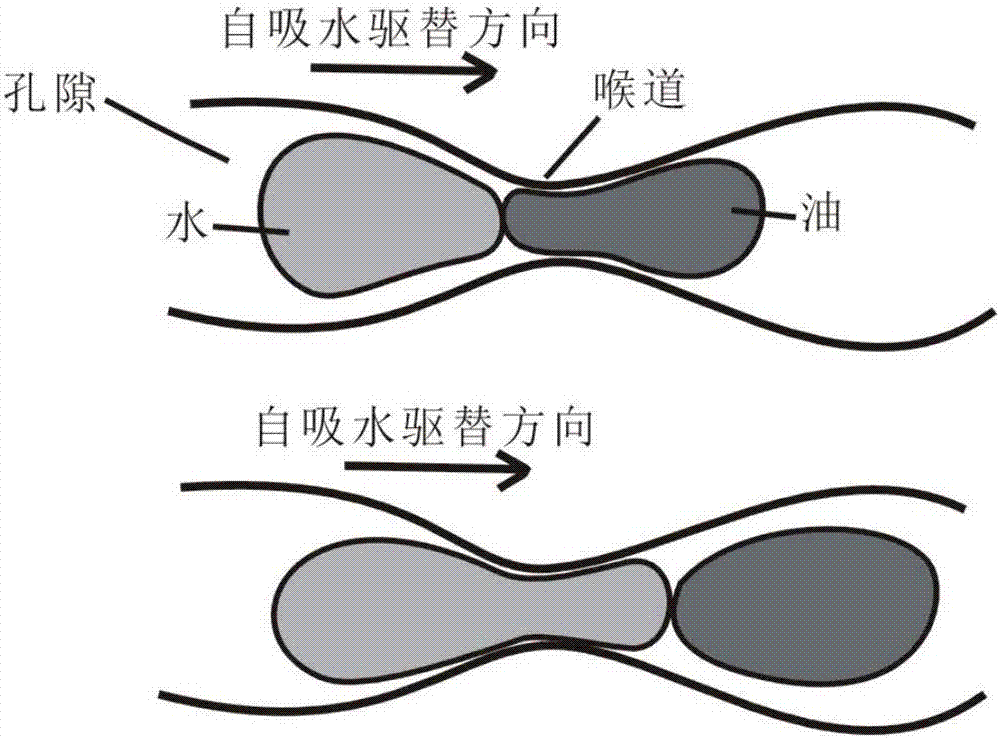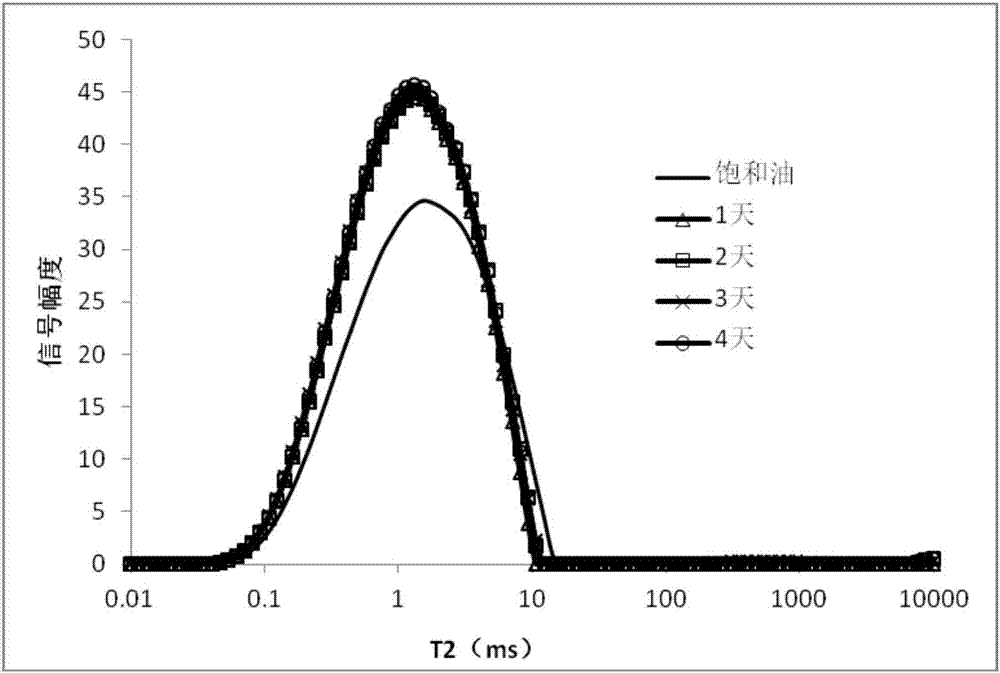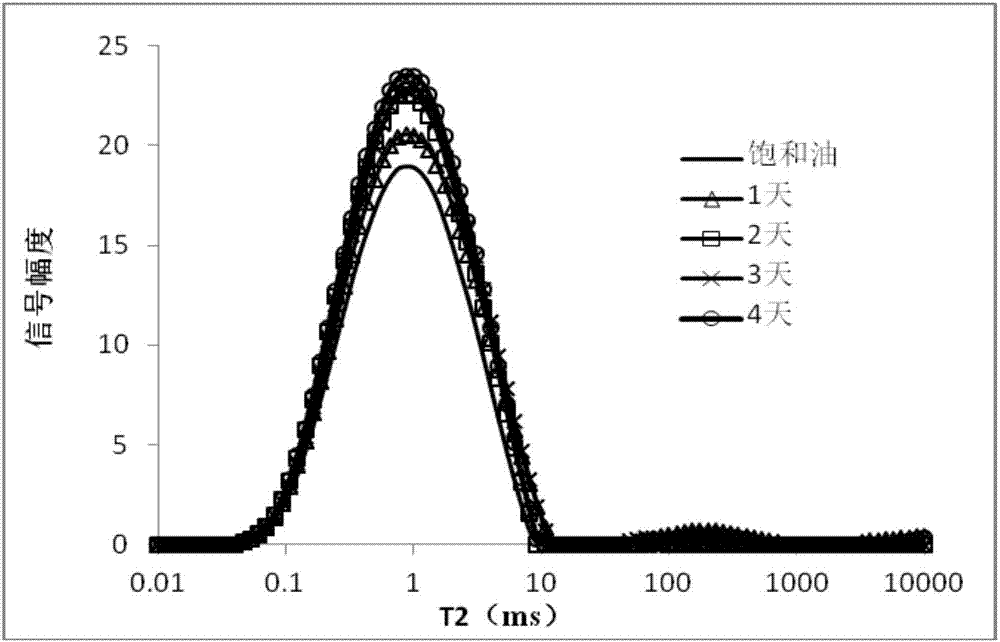Method for evaluating shale oil reservoir water self-absorption oil-displacement effect and oil-displacement time
A shale oil displacement technology, which is applied in the field of evaluating the self-absorption water displacement effect of shale oil reservoirs and determining the best self-absorption water displacement time. Object etc.
- Summary
- Abstract
- Description
- Claims
- Application Information
AI Technical Summary
Problems solved by technology
Method used
Image
Examples
Embodiment 1
[0033] A method for evaluating the self-absorption water flooding effect of shale oil reservoirs and determining the best self-absorption water flooding time includes the following steps:
[0034] Step 1. Configure simulated formation water for the experiment to achieve a salinity of 25,000mg / L;
[0035] Step 2. Put the rock core in a high-pressure saturation device to saturate it with fluorine oil without hydrogen nuclei, and measure the nuclear magnetic resonance T 2 Spectroscopy, Statistical NMR T 2 The area surrounded by the spectrum and the X axis is 764.71;
[0036] Step 3: Put the core in the core holder in the constant temperature box, and continuously inject simulated formation water into both ends of the core at a very low speed of 0.01ml / min to carry out the self-absorption water flooding experiment. The experimental temperature is 40°C, and the ring pressure is 5MPa, NMR T measured after 24 hours of self-absorption water flooding 2 Spectroscopy, Statistical NMR ...
Embodiment 2
[0044] A method for evaluating the self-absorption water flooding effect of shale oil reservoirs and determining the best self-absorption water flooding time includes the following steps:
[0045] Step 1. Configure simulated formation water for the experiment to achieve a salinity of 25,000mg / L;
[0046] Step 2. Put the rock core in a high-pressure saturation device to saturate it with fluorine oil without hydrogen nuclei, and measure the nuclear magnetic resonance T 2 Spectroscopy, Statistical NMR T 2 The area enclosed by the spectrum and the X axis is 370.15;
[0047] Step 3: Put the core in the core holder in the constant temperature box, and continuously inject simulated formation water into both ends of the core at a very low speed of 0.01ml / min to carry out the self-absorption water displacement experiment. The experimental temperature is 10°C, and the ring pressure is 25MPa, NMR T measured after 24 hours of self-absorption water flooding 2 Spectroscopy, Statistical N...
Embodiment 3
[0055] Step 1. Configure simulated formation water for the experiment to achieve a salinity of 25,000mg / L;
[0056] Step 2. Put the rock core in a high-pressure saturation device to saturate it with fluorine oil without hydrogen nuclei, and measure the nuclear magnetic resonance T 2 Spectroscopy, Statistical NMR T 2 The area enclosed by the spectrum and the X-axis is 365.64;
[0057] Step 3: Put the core in the core holder in the constant temperature box, and continuously inject simulated formation water into both ends of the core at a very low speed of 0.01ml / min to carry out the self-absorption water displacement experiment. The experimental temperature is 70°C, and the ring force is 0.1Mpa, NMR T measured after 24 hours of self-absorption water flooding 2 Spectroscopy, Statistical NMR T 2 The area enclosed by the spectrum and the X axis is 453.22;
[0058] Step 4. Repeat step 3. The cores are self-absorbed for water flooding for 48 hours, 72 hours, and 96 hours. After s...
PUM
 Login to View More
Login to View More Abstract
Description
Claims
Application Information
 Login to View More
Login to View More - R&D
- Intellectual Property
- Life Sciences
- Materials
- Tech Scout
- Unparalleled Data Quality
- Higher Quality Content
- 60% Fewer Hallucinations
Browse by: Latest US Patents, China's latest patents, Technical Efficacy Thesaurus, Application Domain, Technology Topic, Popular Technical Reports.
© 2025 PatSnap. All rights reserved.Legal|Privacy policy|Modern Slavery Act Transparency Statement|Sitemap|About US| Contact US: help@patsnap.com



